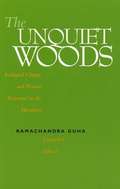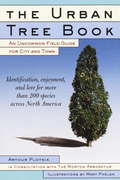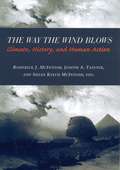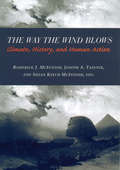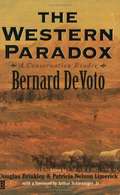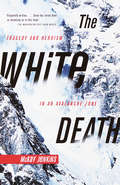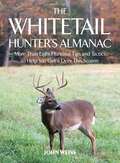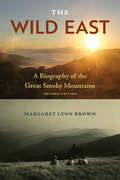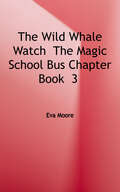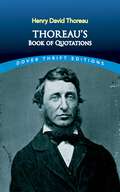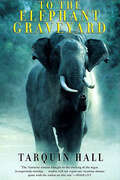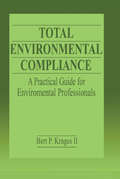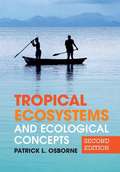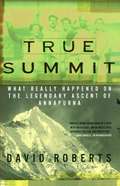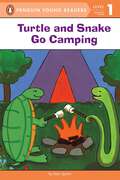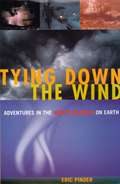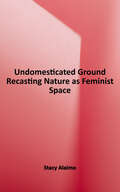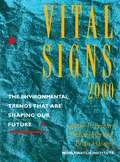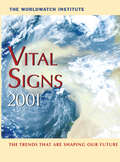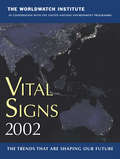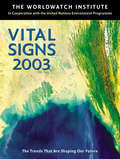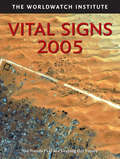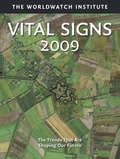- Table View
- List View
The Unquiet Woods: Ecological Change and Peasant Resistance in the Himalaya
by Ramachandra GuhaThe Unquiet Woods, Ramachandra Guha's path breaking study of peasant movements against commercial forestry, offers a new epilogue that brings the story of Himalayan social protest up-to-date, reflecting the Chipko movement's continuing influence in the wider world.
The Urban Tree Book: An Uncommon Field Guide for City and Town
by Arthur PlotnikOpenThe Urban Tree Bookand discover the joys of forest trekking--right in your city or town. This first-of-a-kind field guide introduces readers to the trees on their block, in neighborhood parks, and throughout the urban landscape. Unlike traditional tree guides with dizzying numbers of woodland species, The Urban Tree Book explores nature in the city, describing some 200 tree types likely to be found on North America's streets and surrounding spaces, including suburban settings. With telling descriptions and precise botanical detail, this unique guide not only identifies trees but brings them to life through history, lore, anecdotes, up-to-date facts, and hundreds of fascinating characteristics. More than 175 graceful illustrations capture the charm of trees in urban settings and depict leaf, flower, fruit, and bark features for identification and appreciation. The Urban Tree Bookwill inform even the most knowledgeable plant person and delight urbanites who simply enjoy strolling beneath the shade of welcoming trees. An engaging excursion into the "urban forest," this complete guide to city trees will both entertain and enlighten nature lovers, urban hikers, gardeners, and everyone curious about their environment. Includes a tree planting-and-care section, tree primer, and exploration guide Is backed by the expertise of the renowned Morton Arboretum Incorporates new "urban forestry" perspectives Covers urban trees across the continent Lists key organizations and institutions for tree lovers Selects the best tree sites on the Internet Updates many guides by 20 years
The View from Bald Hill: Thirty Years in an Arizona Grassland
by Carl E. Bock Jane H. BockIn 1540 Francisco Vasquez de Coronado introduced the first domestic livestock to the American Southwest. Over the subsequent four centuries, cattle, horses, and sheep have created a massive ecological experiment on these arid grasslands, changing them in ways we can never know with certainty. The Appleton-Whittell Research Ranch in the high desert of southeastern Arizona is an 8,000-acre sanctuary where grazing has been banned since 1968. In this spirited account of thirty years of research at the ranch, Carl and Jane Bock summarize the results of their fieldwork, which was aimed at understanding the dynamics of grasslands in the absence of livestock. The View from Bald Hill provides an intimate look at the natural history of this unique site and illuminates many issues pertaining to the protection and restoration of our nation's grasslands.
The Way the Wind Blows: Climate, History, and Human Action
by Joseph A. Tainter Susan Keech Mcintosh Roderick J. McintoshScientists and policymakers are beginning to understand in ever-increasing detail that environmental problems cannot be understood solely through the biophysical sciences. Environmental issues are fundamentally human issues and must be set in the context of social, political, cultural, and economic knowledge. The need both to understand how human beings in the past responded to climatic and other environmental changes and to synthesize the implications of these historical patterns for present-day sustainability spurred a conference of the world's leading scholars on the topic. The Way the Wind Blows is the rich result of that conference. Articles discuss the dynamics of climate, human perceptions of and responses to the environment, and issues of sustainability and resiliency. These themes are illustrated through discussions of human societies around the world and throughout history.
The Way the Wind Blows: Climate, History, and Human Action
by Joseph A. Tainter Susan Keech Mcintosh Roderick J. McintoshScientists and policymakers are beginning to understand in ever-increasing detail that environmental problems cannot be understood solely through the biophysical sciences. Environmental issues are fundamentally human issues and must be set in the context of social, political, cultural, and economic knowledge. The need both to understand how human beings in the past responded to climatic and other environmental changes and to synthesize the implications of these historical patterns for present-day sustainability spurred a conference of the world's leading scholars on the topic. The Way the Wind Blows is the rich result of that conference. Articles discuss the dynamics of climate, human perceptions of and responses to the environment, and issues of sustainability and resiliency. These themes are illustrated through discussions of human societies around the world and throughout history.
The Western Paradox: A Conservation Reader
by Arthur M. Schlesinger Bernard Devoto Douglas Brinkley Patricia NelsonThis book is the fascinating record of DeVoto's crusade to save the West from itself.
The White Death: Tragedy and Heroism in an Avalanche Zone
by Mckay JenkinsIn 1969, five young men from Montana set out to accomplish what no one had before: to scale the sheer north face of Mt. Cleveland, Glacier National Park's tallest mountain, in winter. Two days later tragedy struck: they were buried in an avalanche so deep that their bodies would not be discovered until the following June. The White Death is the riveting account of that fated climb and of the breathtakingly heroic rescue attempt that ensued. In the spirit of Peter Matthiessen and John McPhee, McKay Jenkins interweaves a harrowing narrative with an astonishing expanse of relevant knowledge ranging from the history of mountain climbing to the science of snow. Evocative and moving, this fascinating book is a humbling account of man at his most intrepid and nature at its most indomitable.
The Whitetail Hunter's Almanac: More Than 800 Tips and Tactics to Help You Get a Deer This Season (Lyons Press Ser.)
by John Weiss Peter FiducciaTo take the most impressive whitetail bucks, and to bring them in consistently, a hunter has to know his weapons, the woods and, most of all, his quarry. Now, with The Whitetail Hunter’s Almanac at your side, you too can hunt with the strategies and practical wisdom that master hunter John Weiss has learned during his thirty-plus years on the field. Drawing on years of insider research, data studies, and personal experience, Weiss reveals the never-fail methods to making your shots count.Weiss’s expert whitetail hunting secrets include: Little-known facts about whitetails The perfect places to set up blinds and stands Effective ways to use deer scents How to disappear with camouflage Hunting with a rifle, shotgun, or bow And much more!With careful instructions and more than two hundred photographs to bring the hunt to you, The Whitetail Hunter’s Almanac is the must-have reference to make you a more efficient tracker, woodsman, and consistently successful whitetail hunter. If you love the thrill of outwitting a big buck, The Whitetail Hunter’s Almanac is the guide for you!
The Wild East: A Biography of the Great Smoky Mountains
by Margaret Lynn BrownThe classic environmental history of the Great Smoky Mountains, updated with a view from the twenty-first century The Wild East explores the social, political, and environmental changes in the Great Smoky Mountains during the nineteenth and twentieth centuries. Although this national park is most often portrayed as a triumph of wilderness preservation, Margaret Lynn Brown concludes that the largest forested region in the eastern United States is actually a re-created wilderness—a product of restoration and even manipulation of the land. Several hundred years before white settlement, Cherokees farmed and hunted this land. Between 1910 and 1920, corporate lumbermen built railroads into the region’s most remote watersheds and removed more than 60 percent of the old-growth forest. Despite this level of human impact, those who promoted the establishment of a national park in 1934 represented the land as an untouched wilderness and described the people living there as pioneers. Toward the end of the twentieth century, Brown writes, the Smokies faced the consequences of decades of management decisions that fluctuated between promoting human tourism and ensuring environmental preservation. Nearly 25 years after the book’s first publication, this revised edition discusses current research, citizen science initiatives, and land management practices that are restoring native plants and wildlife populations in the twenty-first century. Margaret Lynn Brown emphasizes the extraordinary treasure that is the Great Smoky Mountains and the importance of continuing to invest in the park’s protection for years to come.
The Wild Whale Watch (Magic School Bus Series, The: Chapter Book #3)
by Eva MooreWanda and her classmates accompany Ms. Frizzle on a whale watch, where they learn about whales and have incredible adventures.
Thoreau: A Book of Quotations (Dover Thrift Editions: Speeches/quotations Ser.)
by Henry David Thoreau Bob BlaisdellTo Emerson and other New England transcendentalists who knew him best, Thoreau often seemed prickly and antisocial. But in his writings he was (and is) a man anyone would treasure as a friend, sounding board, and spiritual advisor -- a man who trafficked in that rarest of commodities, the truth. Even now, almost 140 years after his death, his voice remains clear and compelling, and his truths are as relevant and meaningful as they were in his lifetime.In this treasury of more than 450 striking, thought-provoking excerpts from his writing, you will hear him railing against injustice, giving voice to his love of nature, and advocating the simplicity and conscious living that he brought to fruition during his two-year stay at Walden Pond. "To be serene and successful we must be at one with the universe." "Our life is frittered away by detail.... Simplify, simplify."Grouped under 17 headings, including "Education," "Freedom and Individualism," "Friendship and Love," "Human Nature," "Literature and Writing," "Nature," "Season," and "Solitude," the quotations include such favorites as "The mass of men lead lives of quiet desperation" and "Some circumstantial evidence is very strong, as when you find a trout in the milk." Whatever category they are in, Thoreau's observations provide so much inspiration and intellectual nourishment that browsing through this book becomes an exciting voyage of discovery into the heart of the human condition.
To the Elephant Graveyard
by Tarquin Hall“Introduces us to the darker side of the Asian elephant. It is more of a thriller than a straightforward travel book . . . insightful and sensitive.” —Literary ReviewOn India’s northeast frontier, a killer elephant is on the rampage, stalking Assam’s paddy fields and murdering dozens of farmers. Local forestry officials, powerless to stop the elephant, call in one of India’s last licensed elephant hunters and issue a warrant for the rogue’s destruction. Reading about the ensuing hunt in a Delhi newspaper, journalist Tarquin Hall flies to Assam to investigate. To the Elephant Graveyard is the compelling account of the search for a killer elephant in the northeast corner of India, and a vivid portrait of the Khasi tribe, who live intimately with the elephants. Though it seems a world of peaceful coexistence between man and beast, Hall begins to see that the elephants are suffering, having lost their natural habitat to the destruction of the forests and modernization. Hungry, confused, and with little forest left to hide in, herds of elephants are slowly adapting to domestication, but many are resolute and furious. Often spellbinding with excitement, like “a page-turning detective tale” (Publishers Weekly), To the Elephant Graveyard is also intimate and moving, as Hall magnificently takes us on a journey to a place whose ancient ways are fast disappearing with the ever-shrinking forest.“Hall is to be congratulated on writing a book that promises humor and adventure, and delivers both.” —The Spectator“Travel writing that wonderfully hits on all cylinders.” —Booklist“A wonderful book that should become a classic.” —Daily Mail
Total Environmental Compliance: A Practical Guide for Environmental Professionals
by Bert P. Krages IITotal Environmental Compliance: A Practical Guide for Environmental Professionals gives you the background and skills you need to ensure total environmental compliance in your organization. Instead of dryly describing theoretical management systems or reciting regulatory provisions, the author delves into the challenging issues of why organizations
Trees: Their Natural History
by Peter ThomasTrees are familiar components of many landscapes, vital to the healthy functioning of the global ecosystem and unparalled in the range of materials which they provide for human use. Yet how much do we really understand about how they work? This 2000 book provides a comprehensive introduction to the natural history of trees, presenting information on all aspects of tree biology and ecology in an easy to read and concise text. Fascinating insights into the workings of these everyday plants are uncovered throughout the book, with questions such as how are trees designed, how do they grow and reproduce, and why do they eventually die tackled in an illuminating way. Written for a non-technical audience, the book is nonetheless rigorous in its treatment and will therefore provide a valuable source of reference for beginning students as well as those with a less formal interest in this fascinating group of plants.
Tropical Ecosystems and Ecological Concepts
by Patrick OsborneTropical habitats cover over one third of the Earth's terrestrial surface and harbor much of its biodiversity, with many areas rich in endemic species. However, these ecosystems are under significant and growing threat from issues such as deforestation, land degradation and ocean acidification. This introductory textbook provides a comprehensive guide to the major tropical biomes. It is unique in its balanced coverage of both aquatic and terrestrial systems and in its international scope. Each chapter is built around a particular tropical ecosystem, with descriptive case studies providing a framework around which ecological concepts and applied ecological topics are presented. This second edition has been thoroughly updated to reflect recent advances in the field and includes a greater focus on the impact of global climate change. The text is supported throughout by boxes containing supplementary material and is illustrated with over 200 clear, simple line diagrams, maps and photographs.
True Summit
by David RobertsIn a startling look at the classic Annapurna -- the most famous book about mountaineering -- David Roberts discloses what really happened on the legendary expedition to the Himalayan peak. In June 1950, a team of mountaineers was the first to conquer an 8,000-meter peak. Maurice Herzog, the leader of the expedition, became a national hero in France, and Annapurna, his account of the historic ascent, has long been regarded as the ultimate tale of courage and cooperation under the harshest of conditions. In True Summit, David Roberts presents a fascinating revision of this classic tale. Using newly available documents and information gleaned from a rare interview with Herzog (the only climber on the team still living), Roberts shows that the expedition was torn by dissent. As he re-creates the actual events, Roberts lays bare Herzog's self-serving determination and bestows long-delayed credit to the most accomplished and unsung heroes. These new revelations will inspire young adventurers and change forever the way we think about this victory in the mountains and the climbers who achieved it.
Turtle and Snake Go Camping (Penguin Young Readers, Level 1)
by Kate SpohnTurtle and Snake are going camping. Where should they put their tent? They splash through a brook, climb over some rocks, and paddle across a pond, before they find the perfect spot. But the forest is a little too scary at night. These endearing characters help beginning readers gain confidence.
Tying Down the Wind: Adventures in the Worst Weather on Earth
by Eric PinderWhere can you find the worst weather on earth? This book's surprising answer is: everywhere. You don't need to climb Mount Everest or voyage to the icy desert of Antarctica to witness both the beauty and the destructiveness of weather. The same forces are at work in your own backyard. Tying Down the Wind takes readers on a journey of discovery through the atmosphere, a swirling ocean of air that surrounds and sustains life. The adventure begins in a sunny New England woodlot and ends atop the polar ice of Antarctica-where we learn, remarkably, that the two extremes are not so different after all. What triggers changes in the weather? How are tornadoes, thunderstorms, heat waves, and blizzards all related? Tying Down the Wind supplies the answers. It will appeal to fans of nature writing and outdoor adventure, as well as anyone interested in understanding the weather that surrounds us.
Undomesticated Ground: Recasting Nature As Feminist Space
by Stacy AlaimoFrom "Mother Earth" to "Mother Nature," women have for centuries been associated with nature. Feminists, troubled by the way in which such representations show women controlled by powerful natural forces and confined to domestic space, have sought to distance themselves from nature. In Undomesticated Ground, Stacy Alaimo issues a bold call to reclaim nature as a feminist space. Her analysis of a remarkable range of feminist writings-as well as of popular journalism, visual arts, television, and film-powerfully demonstrates that nature has been and continues to be an essential concept for feminist theory and practice. Alaimo urges feminist theorists to rethink the concept of nature by probing the vastly different meanings that it carries. She discusses its significance for Americans engaged in social and political struggles from, for example, the "Indian Wars" of the early nineteenth century, to the birth control movement in the 1920s, to contemporary battles against racism and heterosexism. Reading works by Catherine Sedgwick, Mary Austin, Emma Goldman, Nella Larson, Donna Haraway, Toni Morrison, and others, Alaimo finds that some of these writers strategically invoke nature for feminist purposes while others cast nature as a postmodern agent of resistance in the service of both environmentalism and the women's movement. By examining the importance of nature within literary and political texts, this book greatly expands the parameters of the nature writing genre and establishes nature as a crucial site for the cultural work of feminism.
Vital Signs 2000
by The Worldwatch InstituteThe global trends documented in Vital Signs 2000--from the rapid rise in the sales of energy-efficient compact fluorescent lamps to the worldwide overpumping of growndwater--will play a large role in determining the quality of our lives and our children's lives in the next decade.
Vital Signs 2001: The Environmental Trends That Are Shaping Our Future (Vital Signs)
by The Worldwatch InstituteThe global trends documented in Vital Signs 2001 - from the rapid increase in the use of wind power to the continued warming of the planet - will play a large role in determining the quality of our lives and our children's lives in this new century.
Vital Signs 2002 (Vital Signs)
by The Worldwatch InstituteThe 2002 edition features more than 50 key indicators of long-term trends - from the growth of fish farms and bicycle production to the increase in solar cell and Internet use.
Vital Signs 2003 (Vital Signs)
by The Worldwatch InstituteWith Vital Signs 2003, you'll have the cogent analysis you need to prepare for tomorrow's challenges.
Vital Signs 2005 (Vital Signs)
by The Worldwatch InstituteThis much-anticipated edition of Vital Signs covers 35 global trends that are shaping our future. From carbon emissions to loss of wetlands, each trend provides a brief status report on the topic plus graphs and charts that offer a visual comparison over time. Categories include Food, Economics, Transportation, Health, Governance, Energy and Climate, and Conflict and Peace.
Vital Signs 2009 (Vital Signs)
by The Worldwatch InstituteThis sixteenth volume of Worldwatch's Vital Signs series makes it clear that climate change is both a growing driver of and an increasingly important motivator behind the world's leading economic, social, and environmental trends
